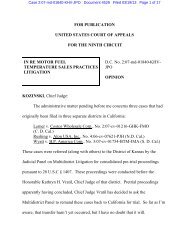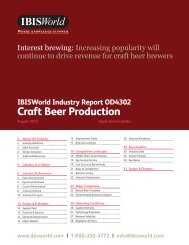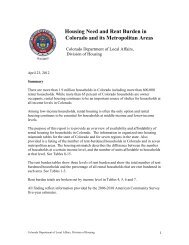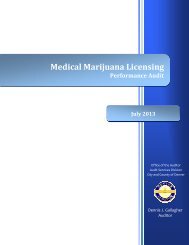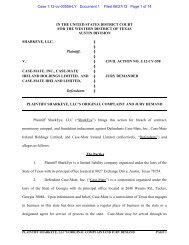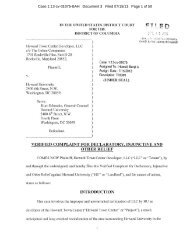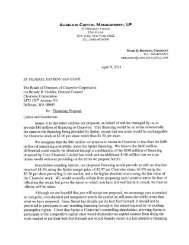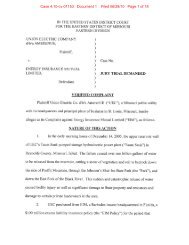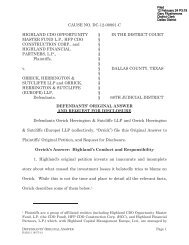UNITED STATES DISTRICT COURT NORTHERN ... - Bizjournals
UNITED STATES DISTRICT COURT NORTHERN ... - Bizjournals
UNITED STATES DISTRICT COURT NORTHERN ... - Bizjournals
Create successful ePaper yourself
Turn your PDF publications into a flip-book with our unique Google optimized e-Paper software.
Case 1:13-cv-03241-AT Document 1 Filed 09/30/13 Page 1 of 64<strong>UNITED</strong> <strong>STATES</strong> <strong>DISTRICT</strong> <strong>COURT</strong><strong>NORTHERN</strong> <strong>DISTRICT</strong> OF GEORGIAATLANTA DIVISIONGEORGIA AQUARIUM, INC.,v.Plaintiff,PENNY PRITZKER, in her OfficialCapacity as Secretary of Commerce,NATIONAL OCEANIC ANDATMOSPHERIC ADMINISTRATION,and NATIONAL MARINE FISHERIESSERVICE,Defendants.)))))))))))))))Civil Action No. _________COMPLAINT FOR DECLARATORYAND INJUNCTIVE RELIEFPlaintiff Georgia Aquarium, Inc. (“Georgia Aquarium” or “Aquarium”)brings this Complaint and shows the Court as follows:INTRODUCTION1. Plaintiff Georgia Aquarium brings this action pursuant to the MarineMammal Protection Act (“MMPA”), 16 U.S.C. §1361, et seq., and seeks judicialreview of Defendants’ decision to deny the Aquarium a permit to import 18 belugawhales (Delphinapterus leucas) from Russia to the United States for the purpose of
Case 1:13-cv-03241-AT Document 1 Filed 09/30/13 Page 2 of 64public display. Defendants’ decision violates the MMPA and the AdministrativeProcedure Act (“APA”), 5 U.S.C. §701, et seq.2. On June 15, 2012, Georgia Aquarium submitted an applicationpursuant to the MMPA for a permit to import 18 beluga whales from Russia to theUnited States. Georgia Aquarium submitted the permit application only aftersponsoring a multi-year peer reviewed research program that determined thecollection of the whales by the Russians did not adversely affect the population inthe wild. Defendants stated the application was the most thorough applicationDefendants had ever received.3. The whales to be imported had been collected from the Sea ofOkhotsk by Russian experts under the supervision of a scientific institute affiliatedwith the Russian Academy of Science and in accordance with the laws of Russia.4. The MMPA requires Defendants to issue or deny a permit to importmarine mammals within 30 days after a public hearing is held on the application.16 U.S.C. §1374(d)(5). A public hearing on the Aquarium’s permit applicationwas held October 12, 2012. Defendants denied the permit on August 5, 2013,almost ten months after the public hearing.5. Defendants’ decision to deny the permit violates the MMPA and theAPA because, among other things, the decision (a) is contrary to the purposes,2
Case 1:13-cv-03241-AT Document 1 Filed 09/30/13 Page 3 of 64policies, and provisions of the MMPA; (b) imposes legal standards found nowherein law; (c) employs ad hoc and unsupportable methodologies to assess the effect ofthe collection on the wild population that have not been peer reviewed and havenot been applied to any other permit applicant; (d) ignores the best scientificinformation available; (e) illegally demands that future actions of the RussianFederation comply with Defendants’ interpretation of the MMPA, notwithstandingthe fact that the MMPA is not binding on other sovereign nations and (f) wasbased on considerations not found in the law. Defendants’ actions are arbitrary,capricious, and not in accordance with law.6. The MMPA authorizes a permit applicant to seek judicial review of anagency decision to deny a permit within 60 days of the denial. 16 U.S.C.§1374(d)(6).PARTIES, JURISDICTION, AND VENUE7. This action arises under the MMPA, 16 U.S.C. §1361, et seq., and theAPA, 5 U.S.C. §§701-706.8. Plaintiff Georgia Aquarium, Inc., located in downtown Atlanta,Georgia, is a not-for-profit entity organized under the laws of the State of Georgia.Georgia Aquarium meets all legal standards to house and care for the belugawhales that are the subject of this action. Georgia Aquarium relies on community3
Case 1:13-cv-03241-AT Document 1 Filed 09/30/13 Page 4 of 64support to fund its marine conservation and education programs. Over 18 millionpeople have visited Georgia Aquarium and participated in its educational programssince the Aquarium opened in 2005.9. Defendant Penny Pritzker is the Secretary of Commerce and is sued inher official capacity. She is ultimately responsible for overseeing the properadministration and implementation of the MMPA with respect to marine mammalssubject to her department’s jurisdiction, which includes beluga whales.10. Defendant National Oceanic and Atmospheric Administration(“NOAA”) is an agency of the United States Department of Commerce withsupervisory responsibility for the National Marine Fisheries Service. TheSecretary of Commerce has delegated her responsibility to ensure compliance withthe MMPA to NOAA which, in turn, has sub-delegated that responsibility to theNational Marine Fisheries Service.11. Defendant National Marine Fisheries Service (“NMFS”) is an agencyof the United States Department of Commerce that has been delegated primaryresponsibility to ensure compliance with the MMPA within the Department ofCommerce.4
Case 1:13-cv-03241-AT Document 1 Filed 09/30/13 Page 5 of 64provides:12. This Court has jurisdiction and venue pursuant to the MMPA whichAny applicant for a permit ... may obtain judicial reviewof the terms and conditions of any permit issued by theSecretary under this section or of his refusal to issue suchpermit. Such review, which shall be pursuant to chapter7 of Title 5, may be initiated by filing a petition forreview in the United States district court for the districtwherein the applicant for the permit resides, or has hisprincipal place of business ... within sixty days after thedate on which such permit is issued or denied.”16 U.S.C. §1374(d)(6). Georgia Aquarium has its principal place of businesswithin this district and this action is filed within 60 days of the denial of the permit.13. This Court also has jurisdiction pursuant to the APA which providesthat final agency action is subject to judicial review. 5 U.S.C. §§701-706.Defendants’ denial of Georgia Aquarium’s permit application is an “agencyaction” subject to judicial review under the APA.14. This Court also has jurisdiction pursuant to 28 U.S.C. §1331 whichgrants the district courts “original jurisdiction of all civil actions arising under the... laws ... of the United States,” and 28 U.S.C. §1361 which grants the districtcourts “original jurisdiction of any action in the nature of mandamus to compel anofficer or employee of the United States or any agency thereof to perform a dutyowed to the plaintiff.”5
Case 1:13-cv-03241-AT Document 1 Filed 09/30/13 Page 6 of 6415. This Court has the authority to grant declaratory relief pursuant to theDeclaratory Judgment Act, 28 U.S.C. §§2201-2202, and may also grant reliefpursuant to the MMPA, 16 U.S.C. §1374(d)(6), as well as the APA, 5 U.S.C. §706.LEGAL BACKGROUND16. The MMPA is intended to conserve and manage marine mammalpopulations because “marine mammals have proven themselves to be resources ofgreat international significance, esthetic and recreational as well as economic....”16 U.S.C. §1361(6).17. The MMPA places a moratorium on the taking of marine mammalswhich can be waived if certain findings are made. 16 U.S.C. §§1371(a), 1373.The MMPA states the term “take” means “to harass, hunt, capture, or kill, orattempt to harass, hunt, capture, or kill any marine mammal.” 16 U.S.C.§1362(13).18. Certain activities were deemed sufficiently important that a mandatedwaiver of the taking moratorium was included in the MMPA. 16 U.S.C. §1371(a).Two such exempted activities are the taking and importation of marine mammalsfor public display. 16 U.S.C. §1371(a)(1).19. Senator Hollings, the Chairman of the Subcommittee that wrote theSenate version of the MMPA in 1972 explained the special treatment for public6
Case 1:13-cv-03241-AT Document 1 Filed 09/30/13 Page 7 of 64display, stating that without observing marine mammals in oceanaria the“magnificent interest” in these animals will be lost and “none will ever see themand none will care about them....” Ocean Mammal Protection Hearings Before theSubcommittee on Oceans and Atmosphere, Senate Commerce Committee, 92ndCong., 2d Sess., 266 (1972). During consideration of the 1988 amendments to theMMPA, Congress reaffirmed the public display exemption. The House ofRepresentatives Committee Report stressed that “[E]ducation is an important toolthat can be used to teach the public that marine mammals are resources of greataesthetic, recreational and economic significance, as well as an important part ofthe marine ecosystem. It is important, therefore, that public display permits beissued to entities that help inform the public about marine mammals as well asperform other functions.” H. Rep. No. 970, 100th Cong., 2d Sess., 33-34 (1988).The importance of the public display exemption was again recognized in the 1994amendments to the MMPA where the Report of the Senate Committee onCommerce, Science, and Transportation stated: “The MMPA recognizes that[public] display provides an important educational opportunity to inform the publicabout the esthetic, recreational, and economic significance of marine mammals andtheir role in the ecosystem.” S. Rep. No. 220, 103rd Cong., 2d Sess., 4 (1994).7
Case 1:13-cv-03241-AT Document 1 Filed 09/30/13 Page 8 of 6420. Notwithstanding this exemption, the MMPA makes it unlawful toimport into the United States any marine mammal if that mammal was: (a)pregnant at the time of taking; (b) nursing at the time of taking, or less than eightmonths old, whichever is later; (c) taken from a stock designated as depleted(beluga whales in Russia are not so designated); or (d) taken in an inhumanemanner. 16 U.S.C. §1372(b). It is also unlawful to import any marine mammaltaken in violation of the MMPA or taken in another country in violation of the lawsof that country. 16 U.S.C. §1372(c)(1).21. Permits for the taking or importation of marine mammals for publicdisplay are issued pursuant to 16 U.S.C. §1374. That section of law provides thatpermits for the taking or importation of marine mammals shall be consistent withany applicable regulations established under 16 U.S.C. §1373 and shall specify:(a) the methods of capture, supervision, care, and transportation which must beobserved pursuant to a taking or importation; (b) the number and kind of animalsto be taken or imported; (c) the location from which the animals may be taken orimported and the manner in which they may be taken, which manner must behumane; (d) the duration of the permit; and (e) other terms and conditions deemedappropriate. 16 U.S.C. §§1374(b) and 1374(c)(1).8
Case 1:13-cv-03241-AT Document 1 Filed 09/30/13 Page 9 of 6422. Persons eligible to receive a permit to take or import a marinemammal for public display must (a) offer a program for education or conservationpurposes that is based on professional recognized standards of the public displaycommunity; (b) be registered or hold a license issued under 7 U.S.C. §2131, etseq.; and (c) maintain facilities that are open to the public on a regularly scheduledbasis such that access is not limited except by the charging of an admission fee. 16U.S.C. §1374(c)(2)(A).23. The MMPA vests authority over certain marine mammals with theSecretary of Commerce and for other marine mammals with the Secretary of theInterior. Authority over the order Cetacea is given to the Secretary of Commerce.16 U.S.C. §1362(12)(A). Beluga whales belong to the order Cetacea.24. The Secretary of Commerce (“Secretary”) has promulgatedregulations implementing the MMPA provisions regarding the taking or import ofmarine mammals for public display and certain other purposes. Those regulationsprovide that before issuing a permit “the applicant must demonstrate” that (a) theproposed activity “is humane and does not present any unnecessary risks to thehealth and welfare” of the animals; (b) the proposed activity is consistent withrestrictions imposed by the Secretary which are set forth in 50 C.F.R. §216.35;(c) if the proposed activity involves species protected under the Endangered9
Case 1:13-cv-03241-AT Document 1 Filed 09/30/13 Page 10 of 64Species Act (beluga whales in Russia are not so protected), the activity isconsistent with that Act; (d) the proposed activity “by itself or in combination withother activities, will not likely have a significant adverse impact on the species orstock;” (e) the applicant has adequate expertise, facilities, and resources tosuccessfully accomplish the objectives and activities stated in the application;(f) the applicant has adequate qualifications, facilities, and resources for the propercare and maintenance of the marine mammal if a live animal will be held captiveor transported; and (g) the requested import will not likely result in the taking ofmarine mammals beyond those authorized by the permit. 50 C.F.R. §216.34(a).25. Regulations promulgated by the Secretary set forth at 50 C.F.R.§216.35 provide that other restrictions shall apply to all permits for taking orimport for public display and certain other purposes. Those restrictions are that:(i) the taking or import complies with applicable regulations; (ii) the maximumperiod for a permit shall not exceed five years; (iii) marine mammals to beimported must be taken and imported in a humane manner and in compliance withany applicable law; (iv) the permit holder shall not import any marine mammal thatis pregnant or lactating at the time of taking or import, or is unweaned or less thaneight months old unless such import is specifically authorized; (v) captive marinemammals shall not be released to the wild unless such release is authorized; (vi)10
Case 1:13-cv-03241-AT Document 1 Filed 09/30/13 Page 11 of 64the permit holder is responsible for all activities occurring under the permit; (vii)persons operating under the permit must possess qualifications commensurate withthe activities undertaken; (viii) persons who require federal or state licenses toconduct activities under the permit have such licenses; (ix) the permit is nottransferable; and (x) the permit holder shall possess a copy of the permit.26. The MMPA directs the Secretary of Commerce or the Secretary of theInterior, depending on the species that is subject to the application, to publishnotice in the Federal Register of each permit application submitted pursuant to 16U.S.C. §1374 and to invite public comments for 30 days. 16 U.S.C. §1374(d)(2).Within 30 days of the close of the public comment period, or within 30 days afterthe date of any public hearing held on the permit application, the applicableSecretary is directed to issue a decision granting or denying the permit. 16 U.S.C.§1374(d)(5).FACTUAL BACKGROUNDA. The Georgia Aquarium27. Georgia Aquarium features a collection of 19,539 animalsrepresenting 737 species, including beluga whales. The Guinness Book of WorldRecords named the Aquarium as the world’s largest in its 2011 edition. GeorgiaAquarium has the requisite license from the U.S. Department of Agriculture11
Case 1:13-cv-03241-AT Document 1 Filed 09/30/13 Page 12 of 64Animal and Plant Health Inspection Service to own and maintain the species in itscare. The Aquarium also meets the requirements in the MMPA regarding publicdisplay facilities.28. The Aquarium contains nearly ten million gallons of water across sixgalleries and 70 exhibits. The Aquarium receives more than 2.1 million guestsannually, educating them on the living wonders of the aquatic world andencouraging them to care about the challenges faced by free ranging aquaticanimals and their ecosystems. Since its 2005 opening, more than 18 million guestshave visited Georgia Aquarium.29. The Aquarium’s commitment to marine mammals – and belugawhales in particular – is manifested by the Cold Water Quest gallery, currentlyhome to four beluga whales, as well as harbor seals, penguins, and southern seaotters. Within the Cold Water Quest gallery, guests have the opportunity to viewbeluga whales in a naturalistic habitat complemented by multimedia educationaltools and live narrators sharing information about the species.B. The Aquarium’s Educational Mission30. Public education is a core mission of the Aquarium and a principalreason for its creation. The Aquarium’s mission statement states the Aquarium isto be an “educational and scientific institution featuring exhibitions and programs12
Case 1:13-cv-03241-AT Document 1 Filed 09/30/13 Page 13 of 64of the highest standards, offering engaging visitor experiences, and promoting theconservation of aquatic diversity throughout the world.” The mission statementcalls for establishing “formal and informal programs” with Georgia schooldistricts, universities, and educational institutions worldwide “that utilize thefacilities, exhibits, laboratories, marine support equipment, and scientific staff” ofGeorgia Aquarium to further the educational mission of these school districts,universities, and other educational institutions.31. Beluga whales are a principal species of focus in Georgia Aquarium’seducational programs. Beluga whales are the centerpiece of the Cold Water QuestGallery. Education at Georgia Aquarium is facilitated through close observation ofthe animals, education stations, behind-the-scenes tours, interactive computerkiosks, hands-on touch pools, graphics, engaging videos, and live Q&A with staffwho have special training with respect to beluga whales and other arctic species.Reflective of the Aquarium’s special focus on beluga whales is the fact that anumber of the self-guided and instructor-led programs include content and lessonsspecific to beluga whales. The programs focus primarily on helping guests betterunderstand the natural history of beluga whales, as well as current research,conservation, rehabilitation, and rescue efforts for these animals, with an emphasison creating awareness of the unique arctic ecosystem where beluga whales are13
Case 1:13-cv-03241-AT Document 1 Filed 09/30/13 Page 14 of 64found and the many obstacles they face to survive in their natural environment. Inaddition, there are regularly scheduled beluga-specific presentations by trainedAquarium staff members who discuss beluga whales and their natural environment.Presentation topics include the status of beluga whales in the wild and informationabout organizations that are playing an active role conserving belugas. Researchefforts into beluga whale migration and other forms of animal behavior areincluded in the presentation topics.32. Among the educational programs focused exclusively on belugawhales are Sea Life Safari and Discovery Labs. In Sea Life Safari, students aretaught the four basic needs of belugas, focusing on the species’ ability to survive incold-water habitats. In Discovery Labs, students are taught about the status ofbeluga populations around the world, and examine hypothetical wildlifemanagement decisions involving beluga populations by identifying factors that canaffect population size.33. Since its opening in 2005, Georgia Aquarium has had a special focuson students, with hundreds of thousands of students visiting the Aquarium onorganized school field trips focused on classroom exercises and learningexperiences. More than 200,000 of these participants have been enrolled ininstructor-led programs. On average, the Aquarium hosts approximately 85,00014
Case 1:13-cv-03241-AT Document 1 Filed 09/30/13 Page 15 of 64students per year for the instructor-led and self-guided programs. Education aboutbeluga whales figures prominently in those programs. In the school years 2011-2012 and 2012-2013, 236,640 students, teachers, and chaperones visited theAquarium. In addition, since the Aquarium’s opening, more than 160,000 schoolchildren have benefited from the Aquarium’s Sponsored Education AdmissionsProgram that provides free or greatly-reduced admission to underprivilegedstudents, giving them a special opportunity to experience the Aquarium and todevelop an interest in the conservation of aquatic animals. Overall, GeorgiaAquarium has reached more than 780,000 students through outreach programs andAquarium visits.34. The educational impact on guests at Georgia Aquarium and other U.S.zoological institutions is immense. 175 million guests visit U.S. aquariums andzoos annually. Within the last decade alone, accredited U.S. facilities have trainedmore than 400,000 teachers and provided effective teaching materials and handsoninteraction for scientific curriculum around the country. Studies show thatseeing and learning about marine mammals, including belugas, in person increasesunderstanding of the species, as well as the potential impact of environmentalchanges occurring in our oceans.15
Case 1:13-cv-03241-AT Document 1 Filed 09/30/13 Page 16 of 6435. Educational programming at Georgia Aquarium is based on theprofessional standards established by the Association of Zoos and Aquariums andthe Alliance of Marine Mammal Parks and Aquariums and the objectives of theState of Georgia Department of Education that are reflected in the GeorgiaPerformance Standards (“GPS”) for each grade level. Aquarium programs alsomeet the applicable national curriculum standards and feature an evaluationcomponent that meets the GPS.36. At the public hearing on Georgia Aquarium’s permit applicationconducted by NMFS on October 12, 2012, educators testified regarding theimportant role Georgia Aquarium and other zoological facilities play in educatingthe public. Dr. Brian Davis, Ph.D., of Georgia Aquarium, for example, quoted thebook Building a Future for Wildlife which states: “Zoos and aquariums enablepeople to develop appreciation, wonder, respect, understanding, care and concernabout nature .... Zoos and aquariums appeal to a very broad audience and havehuge visitor numbers throughout the world. They therefore have the potential to bea very important source of environmental awareness, training and action for asustainable future.” Dr. Davis then noted that “[a]t Georgia Aquarium we see thiseach day as our guests of all ages utilize our facility to learn, make connections,and take action. We are proud that Georgia Aquarium can serve as a mechanism16
Case 1:13-cv-03241-AT Document 1 Filed 09/30/13 Page 17 of 64of change that can educate and hopefully influence the policy makers of tomorrowto ensure healthy and sustainable beluga populations.”37. Other testimony by educators at the October 12, 2012 NMFS publichearing included the following: “The National Science Teachers Association(NSTA) recognizes and encourages the development of sustained links betweenthe informal institutions and schools. NSTA strongly supports and advocatesinformal science education because we share a common mission and visionarticulated by the National Science Education Standards. Informal scienceeducation complements, supplements, deepens, and enhances classroom sciencestudies. It increases the amount of time participants can be engaged in a project ortopic. It can be the proving ground for curriculum materials. The impact ofinformal experiences extends to the affective, cognitive, and social realms bypresenting the opportunity for mentors, professionals, and citizens to share time,friendship, effort, creativity, and expertise with youngsters and adult learners.Informal science education allows for different learning styles and multipleintelligences and offers supplementary alternatives to science study for nontraditionaland second language learners. It offers unique opportunities throughfield trips, field studies, overnight experiences, and special programs. Informalscience learning experiences offer teachers a powerful means to enhance both17
Case 1:13-cv-03241-AT Document 1 Filed 09/30/13 Page 18 of 64professional and personal development in science content knowledge andaccessibility to unique resources. Informal science education institutions, throughtheir exhibits and programs, provide an effective means for parents and other careproviders to share moments of intellectual curiosity and time with their children.Informal science institutions give teachers and students direct access to scientistsand other career role models in the sciences, as well as to opportunities forauthentic science. Informal science educators bring an emphasis on creativity andenrichment strategies to their teaching through the need to attract theirnoncompulsory audiences. NSTA advocates that local corporations, foundations,and institutions fund and support informal science education in their communities.Informal science education is often the only means for continuing science learningin the general public beyond the school years.”38. The report of the U.S. Commission on Ocean Policy, An OceanBlueprint for the 21st Century, recommends that formal and informal oceaneducation be strengthened to better engage the general public, cultivate a broadstewardship ethic, and prepare a new generation of leaders to meet future oceanpolicy challenges. The report states that aquariums and zoos play an importantrole in achieving their recommendation.18
Case 1:13-cv-03241-AT Document 1 Filed 09/30/13 Page 19 of 6439. The education programs developed and presented at GeorgiaAquarium have received letters of commendation from the University of Georgia,Georgia State University, Georgia Department of Education, Cobb County SchoolDistrict, Clayton County Public Schools, The Lovett School, Marietta CitySchools, Board of Cooperative Educational Services, Fulton County Board ofEducation, and numerous teachers who have brought their students to GeorgiaAquarium. At the October 12, 2012 hearing on the permit application conductedby NMFS, additional testimony commending the Aquarium’s educationalprograms was received from a middle school science teacher, university professor,and elementary school principal.40. Through conservation and education programs presented at theGeorgia Aquarium, visitors interact and experience marine mammals and belugasin a way that teaches them about the ocean environment and motivates themtoward conservation actions. The import of 18 beluga whales will further theAquarium’s educational mission by promoting educational opportunities that teachpeople about beluga whales, as well as other marine animals.41. The import of the 18 beluga whales will also allow for the existenceof a self-sustaining beluga whale population in human care and, therefore, thecontinuation and appropriate expansion of beluga whale education programs.19
Case 1:13-cv-03241-AT Document 1 Filed 09/30/13 Page 20 of 64Having a self-sustaining beluga whale population in human care will allowGeorgia Aquarium and other U.S. public display facilities to continue and expandbeluga whale education programs.C. The Aquarium’s Commitment to Animal Health42. Georgia Aquarium is also home to the Correll Center for AquaticAnimal Health, a state-of-the-art animal health facility with more than 10,500square feet designed by 12 world-renowned veterinary and conservationprofessionals for the purpose of caring for the animals at Georgia Aquarium,conducting research, and teaching aquatic medicine. The Correll Center forAquatic Animal Health is a fully equipped hospital and diagnostic laboratorystaffed by five clinical veterinarians, two veterinary pathologists, a parasitologist, anutritionist, and four veterinary technicians. It is one of the largest and mostmodern aquarium veterinary hospitals in the world.43. Georgia Aquarium is the only facility in the United States with aprogram that integrates an aquarium and a veterinary teaching hospital in thespecialty fields of wildlife medicine and veterinary pathology. To accomplish this,Georgia Aquarium established a partnership with the University of GeorgiaCollege of Veterinary Medicine. The University’s veterinary teaching hospitalenhances Georgia Aquarium’s ability to provide a complete aquatic animal20
Case 1:13-cv-03241-AT Document 1 Filed 09/30/13 Page 21 of 64pathology and clinical medicine program while also providing joint training forveterinary residents, interns, and students.44. The Aquarium’s partnership with the University of Georgia’s Collegeof Veterinary Medicine creates a combined clinical and pathology academicprogram that contributes significantly to the scientific community’s understandingof the underwater world and helps marine mammal experts apply new discoveriesto the husbandry, health care, and conservation of aquatic life. GeorgiaAquarium’s discoveries are published in peer-reviewed scientific publications andshared with other aquariums and academic organizations throughout the world. In2012 alone, 26 peer-reviewed papers were published by Georgia Aquarium.45. The addition of 18 whales to the North American breeding populationwill also allow participating facilities such as Georgia Aquarium to enhanceexisting breeding programs. More than half of the 33 beluga whales currently inaccredited facilities in North America were born in captivity. However, givencurrent population age and dynamics, the current North American breedingpopulation is unsustainable. Thus, Georgia Aquarium and its zoological partnershave created a strategic plan that maximizes the appropriate social groupings forcourtship, breeding, delivery, and post-delivery care. While the 18 whales will beowned by Georgia Aquarium, some will be distributed to other U.S. facilities21
Case 1:13-cv-03241-AT Document 1 Filed 09/30/13 Page 22 of 64pursuant to breeding loan agreements. If the import occurs, this careful populationmanagement process has the potential to extend the current beluga whalepopulation in human care an estimated 60+ years without additional acquisitions.D. The Aquarium’s Commitment to Research46. Research relating to species in the care of Georgia Aquarium is also acore mission of Georgia Aquarium. The Aquarium’s mission statement states theAquarium is to be an institution “[s]upporting, conducting, and disseminating basicand applied research on environmental issues and stimulating our community’s andour visitors’ thoughtful consideration of them....”47. Much can be learned about animals in human care, including belugawhales, that cannot be learned from studying the animals in the wild. As Dr. GreyStafford, Director of Conservation at World Wildlife Zoo and Aquarium, testifiedat the October 12, 2012 public hearing on the permit application, “vitalphysiological and behavioral data” can only be gathered in captivity because “formany physiological parameters, the mere act of collecting information [in the wild]interferes with or dramatically skews the very natural processes one is attemptingto measure.” For example, Dr. Stafford pointed to the importance of understandingthe energy needs of beluga whales related to available food supplies, research thatcan only be done with animals in human care. Dr. Stafford concluded: “Given the22
Case 1:13-cv-03241-AT Document 1 Filed 09/30/13 Page 23 of 64changes now affecting arctic regions, a better understanding of beluga energeticsrepresents some of the physiological and behavioral insights necessary for theconservation of the wild population. [Such information] is increasingly importantto policy makers and scientists making decisions in areas such as balancing theneeds of ecosystem management and setting sustainable fishing levels to ensureadequate food supplies.”48. Dr. Ann Pabst at the University of North Carolina at Wilmingtonsubmitted similar comments to NMFS on the Georgia Aquarium permit applicationstating: “The study of marine mammals in human care has added significantly toour understanding of their biology, and, thus, to our efforts to conserve them in thewild. The controlled conditions provided by research [at] public display facilitieshave permitted careful study of such fields as energetics (i.e., metabolism,locomotion, thermoregulation), and reproductive and sensory biology of a numberof marine mammal species. These data have provided critical baselines that havebeen used to determine how human activities may impact marine mammals in thewild.”49. Dr. Brandon Southall, who is affiliated with the University ofCalifornia, Santa Cruz and Duke University, submitted a comment to NMFS on theGeorgia Aquarium permit application stating: “There is no viable debate about the23
Case 1:13-cv-03241-AT Document 1 Filed 09/30/13 Page 25 of 6451. Beluga whales are a primary research focus of Georgia Aquarium.The import of the 18 beluga whales under the permit will directly increase theopportunities for research that will benefit species in the wild and the care ofstranded animals. In addition, Georgia Aquarium continues to provide funding tounderstand and assess the population size, genetic relationships and spatial usageof the Sea of Okhotsk beluga whales. At the request of NMFS, Georgia Aquariumhas also provided staff, equipment, and funding to assess the status of beluga whalepopulations in Alaska.52. As the next significant phase of its ongoing commitment to belugawhales and other marine species, Georgia Aquarium intends to create acomprehensive, non-intrusive research program to address several research needs,including beluga whale physiology, diving adaptations, bioacoustics, andnutritional requirements.53. These non-intrusive studies will help scientists better understand,among other things, the effects of climate change on belugas, how noise in themarine environment from shipping, resource extraction, etc. affects belugas, andhow allowable fishing levels may affect the prey needs of belugas. Without theimport of the 18 beluga whales, it will not be possible to conduct this research on alarger population and on a more statistically valid basis.25
Case 1:13-cv-03241-AT Document 1 Filed 09/30/13 Page 26 of 64E. The Collection of the Beluga Whales54. The beluga whales to be imported under the proposed permit were notcollected for Georgia Aquarium. When Georgia Aquarium submitted its permitapplication, these animals had already been removed from the wild under permitsissued by the Russian Federation and were part of a pre-existing Russiancollection. The collection was done under the supervision of the A. N. SevertsovInstitute of Ecology and Evolution, part of the Russian Academy of Science.55. The animals that were collected are owned by Russians, not byGeorgia Aquarium. The Russian Federation issues annual permits for thecollection of beluga whales from the Sea of Okhotsk and collecting entities can sellor otherwise dispose of the animals as they wish. Georgia Aquarium has nocontrol over the provisions, terms, or conditions of any collection permit issued bythe Russian Federation. Georgia Aquarium has no control over the number ofanimals a permit authorizes to be collected. Georgia Aquarium does not controlthe disposition of collected animals.56. Recognizing the need to increase the number, age and geneticdiversity of beluga whales in accredited North American public display facilities,Georgia Aquarium placed a non-refundable deposit with a Russian entity permittedby the Russian Federation to collect beluga whales so that the permitted entity26
Case 1:13-cv-03241-AT Document 1 Filed 09/30/13 Page 27 of 64would not sell 18 of its collected whales to another party until after NMFS made adetermination as to whether these animals could be imported into the UnitedStates. Thus, the whales in question were not collected for, nor are they owned by,Georgia Aquarium. If this case is unsuccessful, the decision as to the fate of thewhales will be made by their owner, the Russian collector.57. Of the 18 belugas whales included in the permit application, two werecollected in 2006, eleven were collected in 2010, and five were collected in 2011from the Sakhalin-Amur region of the Sea of Okhotsk. All whales were collectedin accordance with Russian law and under properly issued collection permits. Aspecial scientific panel of the International Union for the Conservation of Natureand Natural Resources noted in an official report published in 2011 that anindependent beluga whale expert and his staff participated in fieldwork in the Seaof Okhotsk in 2007, 2008, and 2010 and “were favorably impressed by the way theexperienced capture team caught and handled the whales.”58. During the short summer collection season, the collection team basedits operations at Chkalova Island in the Sakhalin-Amur region of the Sea ofOkhotsk. This site is approximately eight kilometers (five miles) northwest of theprimary collection site near Baydukova Island. Collection attempts were onlyinitiated during low tide when water depth was shallow (two to four meters [6.6 to27
Case 1:13-cv-03241-AT Document 1 Filed 09/30/13 Page 28 of 6413.1 feet] deep). The collection team sailed with equipment from Chkalova Island,a location near the mid-point of Baydukova Island where belugas are known toforage for salmon in shallow water near shore. As the team sat at anchor, itsearched for beluga groups swimming in shallow waters (approximately two tofour meters deep) using binoculars. The collection team did not chase or drivewhales into shallow waters. Instead, the team only engaged whales that werealready located in shallow nearshore waters or those that were moving voluntarilyin the direction of such shallow waters. For groups fitting the latter description,the collection team would track the location of the group from a distance andwould act only after the whales swam into sufficiently shallow water.59. When a group of belugas was detected, the collection team conductedan initial visual assessment using binoculars to estimate the number and age of theanimals present and to identify the presence of any newborn calves, mother-calfpairs, or juveniles less than one year old. No action was taken by the collectionteam until the initial assessment was completed and the team was certain of thecomposition of the group. This is the same protocol utilized in studies approved byNMFS. Because the collection team could safely engage only a limited number ofwhales in one attempt, the team would not engage if there were more than fiveanimals present. Furthermore, the collection team would not engage any group if28
Case 1:13-cv-03241-AT Document 1 Filed 09/30/13 Page 29 of 64mother-calf pairs, calves, large adults, or juveniles less than one-year old wereidentified during the initial assessment. Groups including mother-calf pairs andcalves were not engaged because calves are not collected, nor does the collectionteam separate calves from their mothers. Additionally, groups with large, matureadults were not engaged because mature adults are too heavy to collect safelywithout specialized equipment.60. The equipment used by the collection team included three baidars(traditional motor/sail boats approximately 14 meters (46 feet) in length with lowfreeboards, a flat deck, and a central outboard motor) and up to 12 other boatsapproximately three meters (9.8 feet) in length with 40 horsepower outboardmotors. Two of the baidars were loaded with half of a seine net measuringapproximately 1.5 kilometers (0.9 mile) in length and eight meters (26.2 feet) indepth with a stretched mesh approximately 30 centimeters (one foot) in cell size.The seine net was constructed of a soft nylon rope and had buoys along the lengthof the top rope and sewn-in, heavy leaded thread along the bottom rope. Thisdesign allows the net to take a vertical orientation once deployed into the water.One-half of the net was placed on each baidar and the two baidars traveled closelyside by side with other boats tied to the stern of each until the net was deployed. A29
Case 1:13-cv-03241-AT Document 1 Filed 09/30/13 Page 30 of 64third baidar was used only if the initial collection attempt conducted by the othertwo baidars failed.61. When a suitable group of belugas was located in sufficiently shallowwater, the collection team would begin engaging the whales. The baidars wouldseparate and encircle the whales by deploying the seine net behind them in acurving trajectory to create a “compass” around the whales. After the compasswas formed, the two ends of the net were tied together to eliminate areas of netoverlap where whales might become trapped. Once the seine net was closedaround the whale group, the team conducted a second visual assessment of theanimals swimming inside the seine net. The examination team included aveterinarian or equally trained animal care specialist. If there were any newborncalves, mother-calf pairs, large adults, or juveniles less than one-year old present,the net was opened and all of the animals allowed to exit. If the net did not includenewborn calves, mother-calf pairs, large adults, or juveniles less than one-year old,one baidar would sail for the nearby beach of Baydukova Island. There, the baidarwould land onshore and the collection team would begin slowly pulling the net intoshore by hand. This would simultaneously decrease the diameter of the compasswhile moving the whales into still shallower waters where they could be moreeasily handled.30
Case 1:13-cv-03241-AT Document 1 Filed 09/30/13 Page 31 of 6462. As each whale was moved into shallow waters near the onshorebaidar, it was removed from the seine net, transferred to a soft net stretcher, andloosely secured along the sides of the nearby baidar in the water parallel to andfacing the bow of the boat. Each beluga was supervised by one or two teammembers who ensured its safe, unimpeded breathing. With the belugas securedand monitored in this position, the baidars sailed slowly (less than five miles perhour – well within the normal swimming speed for beluga whales) to the ChkalovaIsland camp. The trip to Chkalova Island was undertaken cautiously, with thewhales secured to the baidar in a manner that was both safe and in a position thatensured the unimpeded breathing of the whales.63. Once the baidars had slowly motored to the Chkalova Island campand were in approximately one meter of water, the animals were moved fromalongside the baidar in their net stretchers to shallow water where measurementswere taken and their condition and status was inspected by the on-site veterinarian.They were also often kept partially covered under a section of the small net thatsurrounded them to secure their flippers and avoid injury while being examined.The veterinary examination included a full health assessment of each whale todetermine fitness, condition and status.31
Case 1:13-cv-03241-AT Document 1 Filed 09/30/13 Page 32 of 6464. Once in the large shore side pens at the Chkalova Island site, thebelugas were monitored and cared for by husbandry and veterinary staff from theUtrish Dolphinarium. While in the shore side pens, the whales were fed locallycaughtherring and salmon. Every whale began taking food no later than thesecond day after collection. The beluga whales remained in the shore side pensunder constant supervision and with fulltime medical care for approximately twomonths before they were transported to the Utrish Marine Mammal ResearchStation (“UMMRS”) on the Russian coast of the Black Sea. UMMRS is part of theSevertsov Institute of Ecology and Evolution, created by the Russian Academy ofScience approximately 27 years ago. Its staff of approximately 200 includestrainers, veterinarians, water engineers, scientists, and other support personnel.65. The Georgia Aquarium permit application clearly states no mothercalfpairs were targeted or collected. The animals were collected using a humanemethod that is accepted by scientific methodology worldwide and is consistentwith methods used by NMFS during cetacean health assessments andinterventions. This includes not collecting and retaining mother-calf pairs, animalsthat are less than one year of age, or those that are nursing calves. The collectionand handling of the beluga whales by the Russians was done in accordance with32
Case 1:13-cv-03241-AT Document 1 Filed 09/30/13 Page 33 of 64the Animal Welfare Act, other U.S. and international law, and the bylaws of thezoological associations to which Georgia Aquarium belongs.F. The Sea of Okhotsk Beluga Whale Population and the PermitApplication66. The 18 beluga whales at issue were collected from the Sea of Okhotskin Russia. Prior to deciding to seek a permit to import the whales, GeorgiaAquarium needed to be certain the collections did not adversely affect any belugawhale population. Accordingly, Georgia Aquarium sponsored a multi-yearresearch program that was conducted by the A. N. Severtsov Institute of Ecologyand Evolution of the Russian Academy of Science to evaluate the geneticrelationships, migratory patterns, and status of the Sea of Okhotsk beluga whalepopulations. Before Georgia Aquarium and others sponsored this research, littlewas known about the genetic relationships, migratory patterns, and status of Sea ofOkhotsk beluga whale populations. Gathering such information was consistentwith Georgia Aquarium’s core mission of research, particularly with respect tobeluga whales, which are one of the Aquarium’s species of principal focus.Georgia Aquarium and its partners provided funds to independent scientists whodeveloped and implemented the research program. Georgia Aquarium alone spent$1 million to fund the research program.33
Case 1:13-cv-03241-AT Document 1 Filed 09/30/13 Page 34 of 6467. According to the analysis conducted by scientists of the SevertsovInstitute, the average annual removal of 20 beluga whales from the Sea of Okhotskfrom 2000-2010 is less than one percent of the population group from which thewhales were collected (the whales in the Sakhalin-Amur area) and is below theallowed potential biological removal (“PBR”) for that group.68. The data on population levels and dynamics gathered from the studyby the Severtsov Institute were peer reviewed by a panel of beluga whale expertsselected by the International Union for the Conservation of Nature and NaturalResources (“IUCN”). The resulting report, titled “Report of an IndependentScientific Review Panel,” was published in 2011. The IUCN IndependentScientific Review Panel was comprised of six noted beluga whale experts: Dr. R.R. Reeves, Dr. R. L. Brownell, Jr., Dr. V. Burkanov, Dr. M. C. S. Kingsley, Dr. L.F. Lowry, and Dr. B. L. Taylor. Four of these six scientists are current or formersenior scientists at NMFS. One of the current NMFS scientists is the leader of theNMFS Marine Mammal Genetics Group. One of the former senior NMFSscientists is now the Chairman of the Committee of Scientific Advisers of the U.S.Marine Mammal Commission created under the MMPA.69. As defined by the MMPA, the PBR for a population is the number ofanimals that may be removed from a stock each year without adversely affecting34
Case 1:13-cv-03241-AT Document 1 Filed 09/30/13 Page 35 of 64the population. PBR is calculated based on a formula that has three elements –population size, reproductive rate, and the need, if any, for species recovery.Population size is calculated by taking the number of animals observed on thesurface and multiplying that by a correction factor to account for unobservedanimals swimming below the surface. The IUCN used this formula to estimatePBR. The IUCN panel concluded beluga removal at the levels occurring duringthe years preceding the Georgia Aquarium’s permit application would not have anadverse effect on that population.70. The IUCN panel calculated the PBR for the Sakhalin-Amurpopulation of beluga whales in the Sea of Okhotsk from which the 18 whales werecollected as 29 animals per year. That number was later raised to 30 per yearbased on the IUCN panel recommendation. This is a highly conservative number.The IUCN used assumptions/data regarding population size in the basic PBRformula that are far more conservative than those used by NMFS to calculate PBRwhen NMFS applies the MMPA. The IUCN process for calculating populationsize differed from the NMFS process because (1) the average, not the peak,population count was used, (2) the IUCN panel employed the lowest commonlyused correction factor for animals not seen and counted because they were belowthe surface, and (3) no correction factor was applied for difficult to detect young35
Case 1:13-cv-03241-AT Document 1 Filed 09/30/13 Page 36 of 64animals. In addition, (1) a 20th-percentile minimum population estimate was used,(2) the estimated net productivity (i.e., reproduction) factor was halved, and (3) arecovery factor was applied that again halved the estimated PBR.71. To calculate the PBR, the IUCN expert panel used a minimumpopulation estimate of 2,891, then multiplied that number by one-half the acceptednet productivity rate of 4% for belugas, and then multiplied that number by a 0.5recovery factor. This resulted in an annual PBR of 29 animals, later corrected to30 per year based on data analysis that used an additional pooling of datarecommended by the IUCN panel. This annual PBR is one percent of the IUCNminimum population estimate and well above the 2007-2011 five-year averageremoval of 22 animals. However, if the IUCN had used the population sizeestimation methods, including the population correction factors, NMFS appliespursuant to the MMPA for calculating the PBR for beluga whale stocks in theeastern Chukchi Sea, eastern Bering Sea, and Bristol Bay in the U.S., then theIUCN PBR calculation would increase to 46 per year. The collection of the 18whales proposed for import occurred over a three-year period.72. The IUCN PBR calculations were based on the assumption that thewhales found in the Sakhalin-Amur area are a distinct and separate populationgroup. However, the data indicate this is not the case. The Sea of Okhotsk36
Case 1:13-cv-03241-AT Document 1 Filed 09/30/13 Page 37 of 64features three beluga whale summer aggregations, one in the Sakhalin-Amurregion, one in the adjacent Shantar region (comprised of four bays), and one in theShelikov region. The Shelikov population is distinct from the other two and, basedon existing data and geographic considerations, should not be considered part ofthe Shantar and Sakhalin-Amur aggregations. However, data on migrationpatterns, data regarding the mixing during the breeding season of whales from thegroups that summer in the Shantar and Sakhalin-Amur areas, and genetic analysesall show that the Shantar and Sakhalin-Amur populations are related and should beconsidered as one group for calculating PBR.73. As to genetic analysis, data for 19 microsatellite loci (i.e., nuclearDNA inherited from both parents) indicate the beluga whales in the Shantar regionand the whales in the Sakhalin-Amur region are not genetically differentiated butinstead belong to one genetically homogeneous population. The mitochondrialDNA (“mtDNA”) (i.e., a small part of the cellular DNA usually inherited onlyfrom the mother) data indicate female belugas have a degree of fidelity to specificsummering areas, but it is not absolute and mtDNA is shared by belugas in thedifferent summering areas. The genetic data, particularly for microsatellite loci,indicate there is considerable interbreeding of the animals in all areas in theShantar and Sakhalin-Amur regions over time. The combined microsatellite and37
Case 1:13-cv-03241-AT Document 1 Filed 09/30/13 Page 38 of 64mtDNA data indicate the beluga whales in individual bays in the Shantar andSakhalin-Amur areas are not genetically distinct groups and that beluga whales inthe Shantar and Sakhalin-Amur regions comprise one genetic stock. This meansthat calculation of a PBR should use the number of whales in the entire populationof the Shantar and Sakhalin-Amur region.74. The genetic data are confirmed by satellite tagging data which showthat beluga whales that summer in the Sakhalin-Amur region spend the winter inthe central Sea of Okhotsk. Many experts believe beluga whales that summer inthe Shantar region also spend their winter in the central Sea of Okhotsk. Thebreeding season occurs while the whales are in the winter and spring grounds. Thesatellite tagging data also revealed that two of the 12 whales (17%) that had beentagged during the summer in the Sakhalin-Amur region were resighted the nextsummer in the Shantar region. This is direct evidence that beluga whales moveamong the Shantar and Sakhalin-Amur regions and that both areas should beconsidered as one group for the calculation of PBR. In addition, all of the whalestagged during the summer in the Sakhalin-Amur region spent the fall in the Shantarregion before moving north to the wintering grounds.38
Case 1:13-cv-03241-AT Document 1 Filed 09/30/13 Page 39 of 6475. The combined population estimate of the beluga whales summering inthe various bays in the Sakhalin-Amur and Shantar regions is 9,240 with aminimum population estimate of 8,632. If one uses the PBR calculation methodsemployed by the IUCN, the resulting PBR is 86. If, however, one used the PBRcalculation methodology employed by NMFS under the MMPA for managing theChukchi Sea and the Bering Sea beluga whale populations in the U.S., the PBRwould increase even more.76. The IUCN expert panel that calculated the PBR for the Sakhalin-Amur summer beluga population also addressed the question of whether the belugawhale collection program permitted by the Russian Federation is the only source ofremovals of beluga whales in the Sea of Okhotsk. As to the existence of anyadditional anthropogenic take, the IUCN panel found there was no evidence tosuggest any such take was anything more than minimal and, when combined withthe five-year average annual permitted collection, certainly not high enough toexceed PBR.G. The Permit Decision77. Defendants denied the Georgia Aquarium permit application onAugust 5, 2013.39
Case 1:13-cv-03241-AT Document 1 Filed 09/30/13 Page 40 of 6478. Defendants determined the permit application met most but not all thecriteria set forth in 50 C.F.R. §216.34 and the MMPA for issuance of the permit.79. 50 C.F.R. §216.34(a)(1) requires that the proposed activity be humaneand not present any unnecessary risks to the health and welfare of marinemammals. Defendants found the proposed transport of beluga whales met thisstandard.80. 50 C.F.R. §216.34(a)(2) requires that the proposed activity beconsistent with the restrictions in 50 C.F.R. §216.35, which includes restrictionsrelated to humaneness, a prohibition on importing marine mammals that were“unweaned” or less than eight months of age when taken, and requirements that thepermit applicant possess the necessary qualifications to undertake the proposedactivity. Defendants stated these requirements duplicated other regulations andwould be addressed in the context of those other regulations.81. 50 C.F.R. §216.34(a)(3) requires that activities involving specieslisted under the Endangered Species Act be consistent with that Act. Since belugawhales are not so listed, Defendants found this criterion inapplicable.82. 50 C.F.R. §216.34(a)(4) requires that the proposed activity by itself orin combination with other activities will not likely have a significant adverseimpact on the species or stock. Defendants found this criterion was not met40
Case 1:13-cv-03241-AT Document 1 Filed 09/30/13 Page 41 of 64because Defendants “cannot discount the possibility” that there could be an“undetected” decline in the population of the beluga whales in the Sea of Okhotskand that the live capture of beluga whales for public display “may havecontributed” to the undetected possible decline. Defendants deemed the permitapplication inadequate because it contained no information about the populationtrend of beluga whales found in the Sea of Okhotsk.83. 50 C.F.R. §216.34(a)(5) requires that the permit applicant have theexpertise, facilities, and resources to accomplish the proposed activity. Defendantsfound Georgia Aquarium has the requisite expertise, facilities, and resources.84. 50 C.F.R. §216.34(a)(6) requires that if a live animal is to betransported the permit applicant have qualifications, facilities, and resourcesadequate for the proper care and maintenance of the marine mammal. Defendantsfound Georgia Aquarium meets this standard.85. 50 C.F.R. §216.34(a)(7) requires that the import will not likely resultin the taking of additional marine mammals. Based on language in a 1993Proposed Rule that was never adopted, Defendants found this standard was not metbecause the Russian Federation will not agree to stop issuing permits for the livecapture of beluga whales for public display.41
Case 1:13-cv-03241-AT Document 1 Filed 09/30/13 Page 42 of 6486. 50 C.F.R. §216.34(b) requires Defendants to consider the opinions orviews of scientists or other knowledgeable persons. Defendants stated this wasdone.87. 16 U.S.C. §1372(b) and 50 C.F.R. §216.12(c) prohibit the importationof animals that were pregnant at the time of taking. Defendants found no pregnantanimals were collected.88. 16 U.S.C. §1372(b) and 50 C.F.R. §216.12(c) prohibit the importationof animals that were nursing or less than eight months old, whichever is later, atthe time of taking. Defendants found this standard was not met as to five of thebelugas proposed for import because it was theoretically possible the five were notfully independent of their mothers at the time of collection.89. 16 U.S.C. §1372(b) and 50 C.F.R. §216.12(c) prohibit the importationof a marine mammal from a “depleted” stock. Defendants found the Sea ofOkhotsk stock of beluga whales is not depleted.90. 16 U.S.C. §1372(b) and 50 C.F.R. §216.12(c) make it unlawful toimport any marine mammal not taken in a humane manner. Defendantsdetermined the collection of the 18 beluga whales was performed in a humanemanner.42
Case 1:13-cv-03241-AT Document 1 Filed 09/30/13 Page 43 of 6491. 16 U.S.C. §1372(b) and 50 C.F.R. §216.12(c) prohibit the importationof marine mammals taken in another country in violation of the laws of thatcountry. Defendants found the 18 beluga whales were collected in compliancewith the laws of Russia.H. Defendants’ Decision Making Process92. Before submitting the permit application, Georgia Aquarium met withrepresentatives of Defendants on multiple occasions to discuss the possible permitapplication and to ask what information Defendants needed to have included in theapplication in order to comply with the MMPA. At no time did Defendants statethat population trend data for Sea of Okhotsk beluga whales was a requiredcomponent of a permit application. However, as discussed above, Defendantsfound the permit application did not comply with the MMPA because of theabsence of population trend data.93. Before submitting the permit application, Georgia Aquariumsubmitted a draft of the application to Defendants with a request that Defendantsidentify any additional information required by the MMPA or Defendants so thatDefendants could make a decision regarding the application. The draft permitapplication did not contain population trend data for Sea of Okhotsk belugawhales. The draft application computed the PBR for the Sakhalin-Amur43
Case 1:13-cv-03241-AT Document 1 Filed 09/30/13 Page 44 of 64population group and used PBR as the measure of the sustainability of removals.Defendants did not ask Georgia Aquarium to provide population trend data for Seaof Okhotsk beluga whales. Defendants did not assert that PBR analysis could notbe used to determine the sustainability of removals from a population.Nevertheless, Defendants’ permit denial rejected Georgia Aquarium’s reliance on aPBR analysis, stating PBR analysis could not be used because of the absence ofpopulation trend analysis showing an increasing population.94. When Defendants published a Federal Register notice of receipt of thepermit application, Defendants stated the application was complete,notwithstanding the absence of population trend data which Defendants stated wasrequired in its denial of the permit.95. After reviewing the permit application, Defendants prepared a DraftEnvironmental Assessment on the Georgia Aquarium permit application. Thatdocument stated Defendants proposed to issue the requested permit to GeorgiaAquarium.96. Early in 2013, representatives of Defendants told representatives ofGeorgia Aquarium that the permit had been written and the decision document hadalso been written. A permit is not written unless the agency’s decision is to issue apermit.44
Case 1:13-cv-03241-AT Document 1 Filed 09/30/13 Page 45 of 6497. Subsequently, representatives of Defendants told representatives ofGeorgia Aquarium that the delay in announcing the final agency decision on thepermit application was caused by a disagreement among Defendants’ lawyersregarding whether an environmental assessment or an environmental impactstatement should be prepared pursuant to the National Environmental Policy Act.Defendants would not have been considering the preparation of an environmentalimpact statement regarding the permit decision with its attendant costs and delaysif the agency’s decision was to deny the permit application.98. Subsequent to these events, representatives of Defendants toldrepresentatives of Georgia Aquarium on June 20, 2013 that Defendants wereconcerned that granting the permit to Georgia Aquarium would “open thefloodgates” to more permit applications to collect and/or import animals for publicdisplay. Despite Defendants’ concerns about considering future collection orimport permits for public display, the MMPA specifically authorizes public displayfacilities to submit permit applications for the collection and import of marinemammals for public display.99. The MMPA specifies that Defendants may not issue a permit for theimport or public display of marine mammals without first consulting with the U.S.Marine Mammal Commission and its Committee of Scientific Advisors. The45
Case 1:13-cv-03241-AT Document 1 Filed 09/30/13 Page 46 of 64Commission and its Committee of Scientific Advisors were created, among otherthings, to provide scientific advice to Defendants. 16 U.S.C. §1401, et seq. Afterconsidering the scientific evidence and all of the applicable statutory andregulatory standards, the Commission recommended issuance of the permit. Inaddition, the Agriculture Department’s Animal and Plant Health InspectionService, which has responsibility for overseeing the care and maintenance ofmarine mammals in human care, recommended approval of the permit application.FIRST CLAIM FOR RELIEF(Violation of the MMPA and the APARegarding the Impact of the Import on Wild Populations)100. Plaintiff realleges, as if fully set forth herein, each and everyallegation contained in paragraphs 1 through 99.101. The regulations implementing the MMPA provide that the proposedaction (here the import of 18 previously collected beluga whales) by itself or incombination with other activities will not likely have a significant adverse impacton the species or stock. 50 C.F.R. §216.34(a)(4). Defendants claim the permit, ifissued, would violate this regulation. In applying this regulation, the permit denialstates “the relevant question under the MMPA becomes ‘Is the beluga whale tradein the Sea of Okhotsk sustainable?’”46
Case 1:13-cv-03241-AT Document 1 Filed 09/30/13 Page 47 of 64102. Defendants claim this standard is violated because Defendants“cannot discount the possibility” that there could be an “undetected” decline in thepopulation of beluga whales in the Sea of Okhotsk and that the live capture ofbeluga whales for public display “may have contributed” to this undetected,possible decline.103. Prior to submitting the permit application, Georgia Aquariumsupported research by the A. N. Severtsov Institute of Ecology and Evolution, partof the Russian Academy of Science, to design and implement a multi-year study ofbeluga whales in the Sea of Okhotsk (the “Severtsov Study”) as described above.104. The Severtsov Study verified that the collections of beluga whalesfrom the Sea of Okhotsk as permitted by the Russian Federation were sustainableand were at a level that would not adversely affect the wild population.105. The data and analysis of the Severtsov Study were peer reviewed by apanel of beluga whale experts selected by the IUCN. As described above, theresulting report, titled “Report of an Independent Scientific Review Panel,” waspublished in 2011.106. As described above, the IUCN panel concluded the level of removalsunder permits issued by the Russian Federation is sustainable.47
Case 1:13-cv-03241-AT Document 1 Filed 09/30/13 Page 48 of 64107. The IUCN panel commended the sponsors of the Sea of Okhotskresearch program for funding “the research and monitoring needed to ensure longtermsustainability” of the Sea of Okhotsk beluga collection program approved bythe Russian Federation. The panel also stated it wished “to commend [the researchsponsors] for making the methods and results available for critical, independentscientific evaluation.” Georgia Aquarium was a principal sponsor of the research.108. The IUCN Independent Scientific Review Panel evaluated thesustainability of the collections that had occurred in the Sea of Okhotsk bycomputing the safe potential biological removal (“PBR”) level and comparing thatto the total number of removals. The IUCN Panel stated: “The PBR approach wasdeveloped to estimate levels of annual removals that are compatible with the goalsof the U.S. Marine Mammal Protection Act....” The panel stated the PBR approachit used “meets the ... definition of sustainable.”109. The IUCN panel concluded that the “PBR (sustainable annualremoval) … = 29 belugas.” This number was later increased to 30 based onadditional data analysis recommended and approved by the Panel.110. The IUCN panel “concluded that the sustainability of recent removalscould reasonably be determined by comparing the 2006-2010 mean removals with48
Case 1:13-cv-03241-AT Document 1 Filed 09/30/13 Page 49 of 64a PBR of 29 [later increased to 30]....” The mean live capture for 2006-2010 was20.111. In claiming that issuance of an import permit to Georgia Aquariumwould violate 50 C.F.R. §216.34(a)(4), Defendants stated: “In particular, we reliedon the [IUCN] Committee’s recent report....” Despite stating this, Defendantsignored the conclusions of that report which found the collections from the Sea ofOkhotsk are sustainable. Defendants justified disregarding the report of theIndependent Scientific Review Panel of the IUCN because, in Defendants’ view,using PBR as a measure of sustainable removal levels “is only appropriate wherethe stock is increasing...” and there is no population trend data in GeorgiaAquarium’s permit application showing such an increase. Requiring that PBR canonly be used if there is population trend data showing the population is increasingis an unprecedented legal standard found nowhere in law or regulation.Application of an unsupportable, and heretofore unknown, legal standard isarbitrary, capricious, and not in accordance with law.112. Defendants routinely approve permits and actions using PBR as ameasure of sustainability and do not require data showing that the relevantpopulation stock is increasing. As noted above, when Georgia Aquariumsubmitted a draft of the permit application to NMFS asking what additional data or49
Case 1:13-cv-03241-AT Document 1 Filed 09/30/13 Page 50 of 64information NMFS might need in the final application, NMFS made no request forpopulation trend data. Application of a standard not applied to other permits isarbitrary, capricious, and not in accordance with law.113. Even assuming Defendants have not arbitrarily and capriciouslycreated a new standard allowing them to deny the Georgia Aquarium permitapplication, the relevant beluga whale population in the Sea of Okhotsk is notdeclining. To assert that the population of beluga whales in the Sakhalin-Amurarea has been declining, Defendants manipulated the data. For example,Defendants compared population surveys that multiplied by 12 the number ofwhales sighted on the surface in order to account for submerged whales withpopulation surveys that multiplied the number of whales sighted on the surface bytwo. Such results compare apples to oranges. Defendants committed numerousother errors, including using population counts deemed incorrect by the IUCNscientific review panel and comparing actual population levels in one area withminimum population levels in another area.114. Defendants assert, in the alternative, that even if PBR is the propermeasure of sustainable removals, the total number of removals from the belugawhale population in the Sakhalin-Amur area exceeds the PBR level.50
Case 1:13-cv-03241-AT Document 1 Filed 09/30/13 Page 51 of 64115. However, Defendants’ permit denial admits: “The removals for livecaptureof the beluga whales from the Sea of Okhotsk at the levels reported from2000-2011 should not impede the stock’s growth or recovery.” Defendants’ permitdenial further states: “If the removal of beluga whales for public display were theonly source of mortality from this stock, then it would be increasing at a slowrate.”116. After these admissions, Defendants’ assert there are six sources ofremoval of beluga whales in the Sakhalin-Amur area in addition to public displayremovals that “cannot be fully discounted or assumed to be zero.” However,Defendants admit there is a “lack of substantiated data” regarding any sources ofremoval in addition to public display removals. Nevertheless, Defendantsconcluded these unsubstantiated sources of removal should be assumed to be at alevel that when added to live captures result in the total annual number of takesbeing above the sustainable PBR.117. The first possible source of additional mortality cited by Defendants issubsistence harvests. The permit denial cites a Russian scientist’s report that theannual subsistence take was possibly one-three animals per village. However, theestimate in that report is anecdotal only and is not supported by any scientificinvestigation or analysis. In fact, the alleged subsistence takes referenced in that51
Case 1:13-cv-03241-AT Document 1 Filed 09/30/13 Page 52 of 64report occur only in the Shantar region of the Sea of Okhotsk and not in theSakhalin-Amur area where the 18 beluga whales were collected. There were noreported subsistence takes in that report as to beluga whales found in the Sakhalin-Amur area, which Defendants assert is the relevant population group.118. The second possible source of additional mortality cited byDefendants is deaths associated with live capture. However, the permit denialreports only one such death between 2007 and 2010.119. The third possible source of additional mortality cited by Defendantsis entanglement in fishing nets. However, the permit denial states that since 1915,nearly 100 years ago, only a “few cases have been reported” and that belugawhales are “unusual among cetaceans in their ability to avoid entanglement.”120. The fourth possible source of additional mortality cited by Defendantsis vessel strikes. However, the permit denial states: “There have been no reportsof vessel strikes or evidence of strikes ... reported for this population.”121. The fifth possible source of additional mortality cited by Defendantsis climate change. However, the permit denial states “there are insufficient data tomake reliable predictions on the effects of Arctic climate change on belugawhales....”52
Case 1:13-cv-03241-AT Document 1 Filed 09/30/13 Page 53 of 64122. The sixth possible source of additional mortality cited by Defendantsis pollution. However, the permit denial states: “The effects of pollution onbeluga whales are difficult to determine and there is no basis for integratingpollution into an assessment of biological removal.”123. It is arbitrary, capricious, and not in accordance with law forDefendants to assert, in the absence of any evidence and in the presence ofevidence to the contrary, that additional sources of mortality cause the totalremovals from the number of beluga whales found in the Sakhalin-Amur area toexceed PBR. There is a marked lack of data supporting Defendants’ conclusion.In fact, the IUCN panel found there was no evidence to suggest that any takesbeyond those for public display are anything but minimal, and certainly not highenough to exceed PBR when combined with collections for public display.124. It is also arbitrary, capricious, and not in accordance with law forDefendants to calculate PBR using a methodology not applied to any other permitapplicant. Defendants compared the alleged number of removals to the IUCNpanel’s PBR number. However, as described above, the IUCN panel used amethod to calculate the population level number used in the PBR equation that ismore conservative than the method used by Defendants in calculating PBR underthe MMPA. If Defendants calculated PBR using the same method for determining53
Case 1:13-cv-03241-AT Document 1 Filed 09/30/13 Page 54 of 64the population level number that Defendants use under the MMPA for harvestedbeluga populations in the Chukchi Sea and the Bearing Sea, then the IUCNcalculated PBR would increase to 46. None of the “unsubstantiated” removals ofbeluga whales in the Sakhalin-Amur area about which Defendants are concernedcome close to approaching this PBR number when added to the removals forpublic display.125. Defendants further assert a factor impacting the permit denial was thatthe collection of the 18 whales may impact the matrilineal transmission ofinformation among beluga whales in the Sea of Okhotsk that result in belugasreturning to summer in specific bays.126. With respect to matrilines, the belugas to be imported were collectedover three years (2005, 2010, and 2011) from groups of five or fewer animals.Therefore, any potential disruption of family units that return to specific baysduring the summer because of matrilineal cultural transmission was greatlyminimized. The average annual collection of 20 beluga whales from the Sakhalin-Amur summering group from 2000-2010 represents less than 0.6% of theconservative IUCN population estimate of 3,547 animals. If the method used byDefendants to estimate population size under the MMPA is employed, the annualremoval rate would be 0.3% of the Sakhalin-Amur population. Further, of the 1854
Case 1:13-cv-03241-AT Document 1 Filed 09/30/13 Page 55 of 64whales to be imported, only 10 (56%) are female and these are all young females.Older matriarchal adult females that are important in transmitting culturalinformation were not collected. Further, matrilineal systems are hierarchal,meaning only a portion of the adult females, none of which were collected, areresponsible for the bulk of the cultural transmission. Removal of a few youngfemales long before they can reach any level of hierarchal dominance is unlikely todisrupt existing or future matrilineal complexes. Given the relatively long life spanof these animals, their lifetime fecundity, the number of beluga whales in theSakhalin-Amur summer group, the associated number of matrilines (which couldnumber in the hundreds), and the small number of animals collected annually (ofwhich approximately half are males), the contention that the Russian collectionprogram consistently removes animals from a single matriline to the point ofdepletion is not mathematically supportable.127. Finally, Defendants assert in the permit denial that the collection ofthe 18 beluga whales may cause localized depletion and that this was considered inthe permit denial. Contrary to Defendants’ assertion, the collection of belugawhales in the Sea of Okhotsk will not cause localized depletion or have adversecumulative effects. To conclude otherwise implies that the collections come fromthe same groups or that the same whales are repeatedly captured and released. The55
Case 1:13-cv-03241-AT Document 1 Filed 09/30/13 Page 56 of 64results of satellite tagging studies conducted on beluga whales found in theSakhalin-Amur area during summer indicate the whales collected at the collectionsite (Chkalov and Baydukov Islands) move across the entire 70-mile breadth of theSakhalin-Amur area. Thus, all animals in the area are available for collection, notjust a few local individuals. Since the collection methodology targets groups offive or less whales, mathematically, there could be hundreds of eligible smallgroups to choose from during a collection season. A group of five isapproximately 1/700th of the most conservative Sakhalin-Amur summerpopulation estimate. The likelihood of the same whales being repeatedly capturedis exceedingly remote.128. The MMPA authorizes the Secretary to issue permits for theimportation of marine mammals for public display if issuing the permit complieswith all applicable statutory and regulatory provisions. 16 U.S.C. §§1371(a)(1),1374. The proposed Georgia Aquarium permit complies with all applicablestatutory and regulatory provisions. Defendants’ decision to deny the permitapplication when the applicable statutory and regulatory requirements are metviolates the MMPA. Defendants’ claim that granting the import permit will likelyhave a significant adverse impact on the beluga whales found in the Sakhalin-Amur area violates the MMPA and the APA because it is arbitrary, capricious, and56
Case 1:13-cv-03241-AT Document 1 Filed 09/30/13 Page 57 of 64not in accordance with law. Defendants’ action is based on standards nowherefound in law or regulation, is based on the application of methods and standardsthat have not been applied to any other permit applicant, is not based on the bestscientific evidence, and has no foundation in law or fact.SECOND CLAIM FOR RELIEF(Violation of the MMPA and the APA Regarding Whether thePermit Will Result in Additional Removals from the Sea of Okhotsk)129. Plaintiff realleges, as if fully set forth herein, each and everyallegation contained in paragraphs 1 through 128.130. The regulations implementing the MMPA provide that the proposedaction (here the import of 18 previously collected beluga whales) cannot bepermitted if it is likely to result in the taking of additional beluga whales. 50C.F.R. §216.34(a)(7). Defendants claim the permit, if issued, would violate thisregulation. Thus, Defendants’ permit decision states: “There are ongoing, legalmarine mammal capture operations in Russia that are expected to continue….”131. Defendants’ legal position is that “we cannot obtain assurances that anadditional 18 whales would not be captured in the future....” In other words, unlessa foreign sovereign agrees to never collect another animal, no import permit forpublic display can ever be granted after the first such permit is approved. Theprovisions of the MMPA, however, do not support this interpretation. In fact, the57
Case 1:13-cv-03241-AT Document 1 Filed 09/30/13 Page 58 of 64MMPA specifically authorizes the collection and import of marine mammals forpublic display. 16 U.S.C. §§1371(a)(1) and 1374. Defendants’ permit decisionviolates the MMPA and nullifies these provisions of law by prohibiting any UnitedStates entity from importing a marine mammal if the exporting country, which isnot subject to the MMPA, may allow future collections for public display.132. The factual basis for Defendants’ legal position is Defendants’ beliefthat “issuance of this permit would contribute to the demand to capture belugasfrom this stock for the purpose of public display worldwide, resulting in futuretaking of additional belugas from this stock.” To the contrary, one purpose of theproposed import is to increase the breeding population of beluga whales held ataccredited North American public display facilities such that no further permits forimportation or collection will be sought by such facilities in the foreseeable future.133. Defendants’ Draft Environmental Assessment regarding the permitapplication recognizes it is highly unlikely that there will be future import orcollection applications from facilities subject to the MMPA. That document states:“There are no active permits which authorize the importation of beluga whales inthe U.S., or other permits authorizing the direct collection of marine mammalsfrom U.S. waters for public display. In addition, this application has beensubmitted with the understanding that all facilities holding beluga whales in the58
Case 1:13-cv-03241-AT Document 1 Filed 09/30/13 Page 59 of 64U.S. will be participating in the collective management of these imported animals.Therefore, it is extremely unlikely, but not impossible, for other marine mammalfacilities to request a similar permit in the future.”134. Furthermore, even if an application for import or collection wassubmitted by a facility subject to the MMPA, Defendants’ Final EnvironmentalAssessment regarding the permit application states that any decision on theGeorgia Aquarium permit application is not a precedent for a decision on any otherpermit application and each permit application will be judged on its own merits.135. Given Defendants’ admission that it is “extremely unlikely” that anyfacility subject to the MMPA will submit an application to import or collect belugawhales in the future, Defendants’ sole factual basis for permit denial under 50C.F.R. §216.34(a)(7) is that non-U.S. entities not subject to the MMPA may seekto import into their sovereign countries animals collected in Russia because theimportation of beluga whales by Georgia Aquarium will cause such non-U.S.entities to seek to import beluga whales for public display.136. Defendants offer no evidence that the import of beluga whales into theUnited States will “contribute to the demand” for beluga whales in other countries,particularly when the purpose of the import is to reduce the need for futurecollection.59
Case 1:13-cv-03241-AT Document 1 Filed 09/30/13 Page 60 of 64137. The MMPA authorizes the Secretary to issue permits for theimportation of marine mammals for public display if issuing the permit complieswith all applicable statutory and regulatory provisions. 16 U.S.C. §§1371(a)(1),1374. The proposed Georgia Aquarium permit complies with all applicablestatutory and regulatory provisions. Defendants’ decision to deny the permit whenthe applicable statutory and regulatory provisions are met violates the MMPA.Defendants’ claim that granting the import permit for already collected whales willlikely result in the collection of additional beluga whales in violation of 50 C.F.R.§216.34(a)(7) violates the MMPA and the APA because is contrary to theprovisions of the MMPA allowing the collection and/or importation of marinemammals for public display, illegally applies the MMPA to sovereign nations, andhas no foundation in fact or law. Defendants’ action is arbitrary, capricious, andnot in accordance with law.THIRD CLAIM FOR RELIEF(Violation of the MMPA and APARegarding Importation of Five Beluga Whales)138. Plaintiff realleges, as if fully set forth herein, each and everyallegation contained in paragraphs 1 through 137.60
Case 1:13-cv-03241-AT Document 1 Filed 09/30/13 Page 61 of 64139. The MMPA and its implementing regulations prohibit the import ofmarine mammals that are less than eight months old or nursing at the time oftaking, whichever occurs later. 16 U.S.C. §1372(b)(2), 50 C.F.R. §216.12(c).140. Defendants’ permit decision asserts five of the 18 whales proposed forimport were estimated to be a minimum of 1.5 years of age at the time ofcollection. The permit decision further asserts that beluga whales may nurse fortwo years or longer and, therefore, “[a]t 1.5 years of age, beluga whale calves arelikely not independent from their mothers.” Therefore, Defendants concluded thatgranting the permit application would violate 16 U.S.C. §1372(b)(2) and 50 C.F.R.§216.12(c).141. The stated ages of the whales at the time of capture are estimates. 1.5years is the low end of the estimate. An accurate determination of age requires theintrusive act of pulling a tooth to examine growth layers, much as a tree is aged byexamining growth rings.142. For nursing to occur, there must be a mother-calf pair and a lactatingfemale. No mother-calf pairs were collected. No lactating female was collected.143. At the time of collection and again after collection, a veterinarian orequally trained animal care specialist examined the animals and confirmed thepresence of no lactating female and no nursing calf.61
Case 1:13-cv-03241-AT Document 1 Filed 09/30/13 Page 62 of 64144. Almost immediately after collection, all the belugas were eating solidfood (fish, etc.) for 100% of their dietary needs. This demonstrates the fivebelugas at issue were independent of their mothers. Had any of the youngeranimals been nursing and dependent on their mothers, additional handling andacclimation, followed by formula feeding and weaning to solid food would havebeen required for the animals to survive. For the younger animals to haveacclimated and been eating solid food almost immediately after collection isincompatible with the assertion that the animals were nursing in any dependentway, if at all.145. Defendants offer no evidence contradicting the fact that the fivebelugas were not nursing. Instead, Defendants assert it was theoretically possiblethe animals were nursing.146. The MMPA authorizes the Secretary to issue permits for theimportation of marine mammals for public display if issuing the permit complieswith all applicable statutory and regulatory provisions. 16 U.S.C. §§1371(a)(1),1374. The proposed Georgia Aquarium permit complies with all applicablestatutory and regulatory provisions. Defendants’ decision to deny the permitapplication when the applicable statutory and regulatory requirements are metviolates the MMPA. Defendants’ denial of the permit application based on the62
Case 1:13-cv-03241-AT Document 1 Filed 09/30/13 Page 63 of 64claim that five of the beluga whales proposed for import were nursing at the timeof collection violates the MMPA and the APA because it has no foundation in lawor fact and is arbitrary, capricious and not in accordance with law.PRAYER FOR RELIEFPlaintiff respectfully requests that this Court:A. Maintain jurisdiction over this action until Defendants are incompliance with the MMPA, APA, and every order of this Court inthis action;B. Find that Defendants have violated the MMPA and the APA as setforth above;C. Vacate the denial of the permit to Georgia Aquarium for theimportation into the United States of 18 beluga whales from Russiaand order Defendants to issue the permit and enjoin Defendants fromtaking any action to prevent the import of the whales;D. Award Plaintiff its costs of litigation, including reasonable attorneys’fees and expert witness fees; andE. Grant Plaintiff such further and additional relief as the Court maydeem just and proper under the circumstances.63
Case 1:13-cv-03241-AT Document 1 Filed 09/30/13 Page 64 of 64Dated: September 30, 2013/s/ Daniel F. DiffleyDaniel F. DiffleyGeorgia Bar No. 221703Meaghan Goodwin BoydGeorgia Bar No. 142521ALSTON & BIRD LLP1201 West Peachtree StreetAtlanta, GA 30309-3424Telephone: 404-881-4703Facsimile: 404-253-8572Dan.Diffley@alston.comMeaghan.Boyd@alston.comGeorge J. Mannina, Jr.pro hac vice application pendingNossaman LLP1666 K Street, N.W., Suite 500Washington, D.C. 20006Telephone: (202) 887-1491Facsimile: (202) 466-3215gmannina@nossaman.comAshley J. Remillardpro hac vice application pendingNossaman LLP18101 Von Karman AvenueSuite 1800Irvine, CA 92612Telephone: (949) 477-7635Facsimile: (949) 833-7878aremillard@nossaman.comAttorneys for Plaintiff GeorgiaAquarium, Inc.



